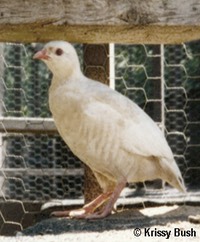• a GENE controls 1 characteristic or trait
• ALLELES are alternative forms of a gene. For example: The GENE is feather colour and the ALLELE is either Blue "a" or Green "A". Say we are studying height. Alleles determine alternative types (tall, short) for the gene (height) that we are studying.
• GENOTYPE is the inherited material received from both parents (e.g.) AA, Aa, or aa
• PHENOTYPE is the physical appearance of the individual (e.g.): Green or Blue
• AUTOSOMAL refers to genes on the non-sex chromosomes (most genes)
• SEX - LINKED refers to genes on the sex chromosomes (X & Y in humans/mammals and Z & W in Birds)
• DOMINANT refers to an allele that is expressed regardless of the other alleles present for the trait being studied. (e.g.) AA & Aa both give green birds, "A" is dominant.
• RECESSIVE refers to the allele that is expressed only when it is the only type of allele present in an organism for the trait being studied (e.g.) "aa" = Blue birds, "a" is recessive.
• HETEROZYGOTES contain 2 different alleles for the trait being studied. The phenotype of the heterozygote indicates which allele is dominant (e.g.) Aa is a heterozygote. Since that bird is green it indicates that "A" allele (responsible for green colour) is dominant.
• HOMOZYGOTES contain identical alleles for the trait being studied. The line may be either homozygous dominant (AA) or homozygous recessive (aa) depending on which allele is present. Either is a true breeding line.
• PUNNETT SQUARE is a method used to determine all of the possible genotypes of the offspring and the probability that a given genotype will occur when the genotypes of the two parents are known. This is done in chart format. See Single gene and Double gene mutations for examples.
• POLYMORPHISM means many forms. It is the existence in a population of 2 or more common phenotypic variations for a trait. The different variants are called morphs. (e.g.) several different feather colours for the feather colour gene.
DEFINITIONS RELATING TO BREEDING PRACTICES
• PURE LINE is a strain that breeds true for that trait being studied (e.g.) Blue X Blue will always give you Blue chicks
• PARENTAL GENERATION (P) is the generation from which the first cross in a series is taken. Usually, but not always, the parents are true breeding.
• FIRST FILIAL GENERATION (F1) consists of progeny/offspring from the parental generation. (e.g.) If you are the parental generation then your kids are the first filial generation.
• SECOND FILIAL GENERATION (F2) consists of progeny from the first filial generation (e.g.) Your grand kids.
• TEST CROSS is a cross of a homozygous recessive organism (aa) with an organism of dominant appearance (AA or Aa). It results in a 1:1 ratio if an organism with the dominant appearance is heterozygous (Aa) and a 1:0 ratio if the organism with the dominant appearance is homozygous (AA)
• RECIPROCAL CROSS involves a pair of crosses that switch the trait being studied with the sex of the parent carrying that trait. (e.g.) Cross #1 Blue (male) X Green (female). Cross # 2 or the reciprocal cross to # 1 would be Blue (female) X Green (Male).
TERMINOLOGY PERTAINING TO GENES & ALLELES (NOT SPECIES OR INDIVIDUALS)
• HYBRIDS are the same as heterozygotes (Aa).
• MONOHYBRID refers to a single gene pair. F1 monohybrid crosses lead to a 1:2:1 ratio (e.g.) (P) Split (Aa) X Split (Aa)
(F1) 25% Green (AA), 50% Split (Aa), 25% Blue (aa)
1 : 2 : 1
• DIHYBRID refers to 2 gene pairs being studied simultaneously. F1 dihybrid crosses result in a 9:3:3:1 ratio (e.g.)
(P) Split to Blue/Split to Yellow (AaBb) X Split to Blue/Split to Yellow (AaBb)
(F1) 56.25% Green Birds, 18.75% Blue, 18.75% Yellow, 6.25% White
9 : 3 : 3 : 1
TERMINOLOGY USED IN PEDIGREE ANALYSIS
• PROPOSITUS is the individual that first called attention to the family being studied (e.g.) the first blue mutant that came from green parents.
• CARRIER can refer to a heterozygous individual for either an autosomal or sex-linked trait. For autosomal it can be either sex, just needs to have a dominant copy of the gene "A" and a recessive copy of the gene "a". In this sense it is equivalent to a Split. For Sex-linked, only female humans/mammals and male birds can be carriers because they are the only sex which possesses 2 chromosomes which can hold the gene of interest. A carrier in this case must also have a dominant copy of the gene "A" and a recessive copy of the gene "a".
REFERENCES
Griffiths, A. J. F., Miller, J. H., Suzuki, D. T., Lewontin, R. C., and Gelbart, W. M. 1996. An Introduction to Genetic Analysis Sixth Edition. W.H. Freeman and company. New York.
